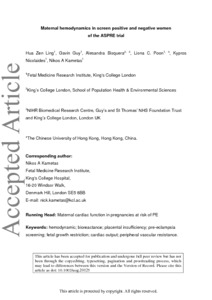Ling, HZ; Guy, GP; Bisquera, A; Poon, LC; Nicolaides, KH; Kametas, NA
(2019)
Maternal hemodynamics in screen‐positive and screen‐negative women of the ASPRE trial.
Ultrasound in Obstetrics & Gynecology, 54 (1).
pp. 51-57.
ISSN 0960-7692
https://doi.org/10.1002/uog.20125
SGUL Authors: Guy, Gavin Paul
![[img]](https://openaccess.sgul.ac.uk/111578/1.hassmallThumbnailVersion/Maternal_hemodynamics_in_screen_LING_Accepted13September2018_GREEN_AAM.pdf)  Preview |
|
PDF
Accepted Version
Available under License ["licenses_description_publisher" not defined].
Download (949kB)
| Preview
|
Abstract
Objective
To compare maternal hemodynamics and perinatal outcome, in pregnancies that do not develop pre‐eclampsia (PE) or deliver a small‐for‐gestational‐age (SGA) neonate, between those identified at 11–13 weeks' gestation as being screen positive or negative for preterm PE, by a combination of maternal factors, mean arterial pressure, uterine artery pulsatility index, serum placental growth factor and pregnancy associated plasma protein‐A.
Methods
This was a prospective longitudinal cohort study of maternal cardiovascular function, assessed using a bioreactance method, in women undergoing first‐trimester screening for PE. Maternal hemodynamics and perinatal outcome were compared between screen‐positive and screen‐negative women who did not have a medical comorbidity, did not develop PE or pregnancy‐induced hypertension and delivered at term a live neonate with birth weight between the 5th and 95th percentiles. A multilevel linear mixed‐effects model was used to compare the repeated measures of cardiac variables, controlling for maternal characteristics.
Results
The screen‐negative group (n = 926) had normal cardiac function changes across gestation, whereas the screen‐positive group (n = 170) demonstrated static or reduced cardiac output and stroke volume and higher mean arterial pressure and peripheral vascular resistance with advancing gestation. In the screen‐positive group, compared with screen‐negative women, birth‐weight Z‐score was shifted toward lower values, with prevalence of delivery of a neonate below the 35th, 30th or 25th percentile being about 70% higher, and the rate of operative delivery for fetal distress in labor also being higher.
Conclusion
Women who were screen positive for impaired placentation, even though they did not develop PE or deliver a SGA neonate, had pathological cardiac adaptation in pregnancy and increased risk of adverse perinatal outcome.
Statistics
Item downloaded times since 20 Nov 2020.
Actions (login required)
 |
Edit Item |


